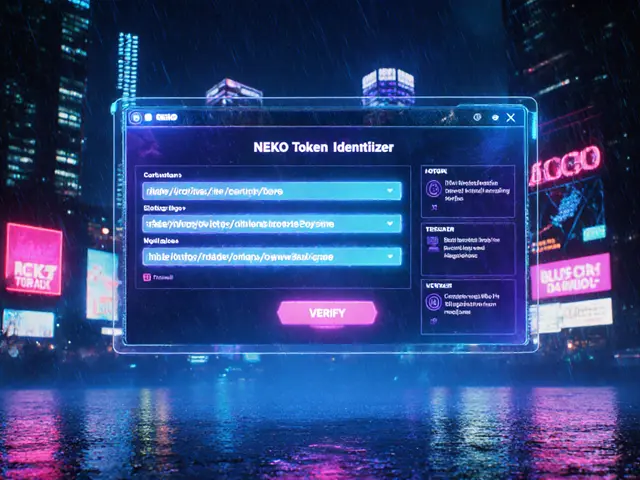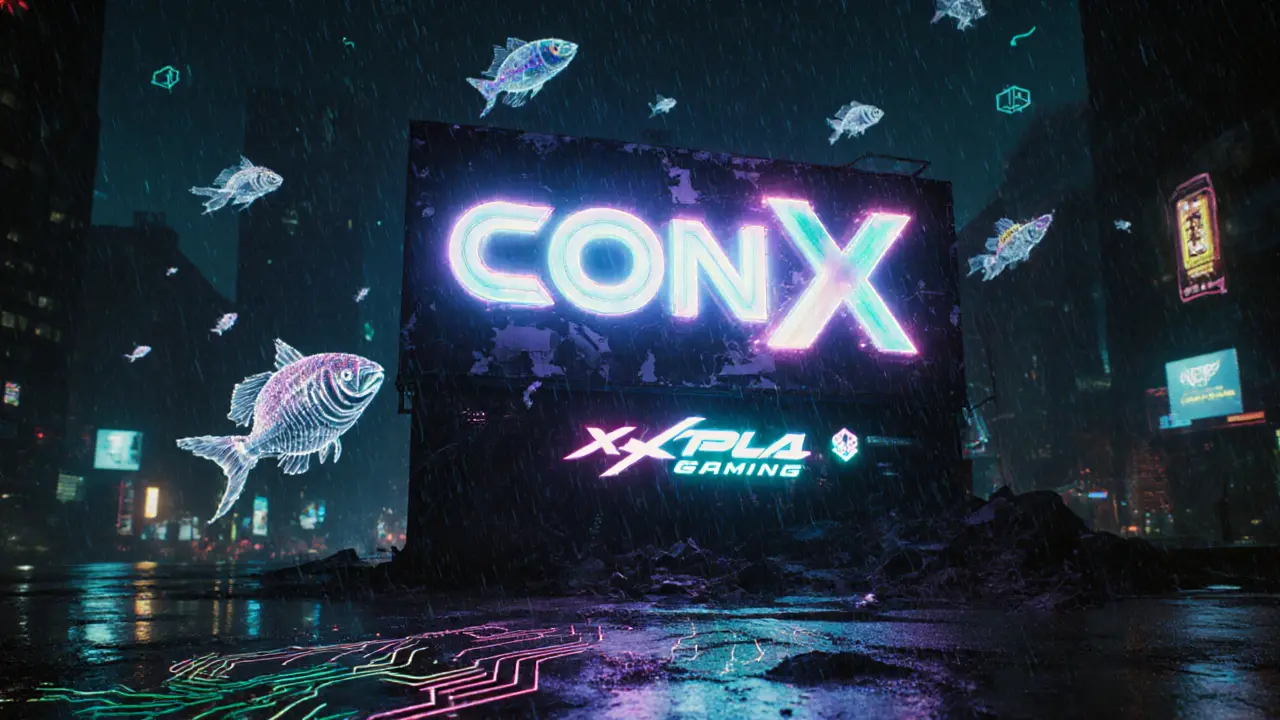XPLA/CONX Investment Calculator
Projection Scenarios
XPLA was once a Layer 1 blockchain built for digital media and gaming, but today it’s better known as CONX - a rebranded platform aiming to connect culture, finance, and technology. If you’re looking at XPLA right now, you’re seeing the ghost of a project that changed its name, mission, and direction. Understanding what XPLA was - and what it’s becoming - helps you make sense of its price swings, low trading volume, and why some developers still build on it while others walk away.
What XPLA actually was
XPLA launched in 2021 as a blockchain designed for creators and gamers. It wasn’t trying to be the next Ethereum or Solana. Instead, it focused on one thing: letting people own what they create and earn in digital worlds. The idea was simple - if you spend hours playing a game, farming items, or building content, you should own those assets. That’s where the “Play to Own” model came from. Unlike “Play to Earn,” which often feels like a grind for tokens, “Play to Own” promised real value tied to in-game items, skins, and even digital art. Built on the Cosmos SDK and using Tendermint’s Byzantine Fault Tolerant consensus, XPLA was fast, secure, and designed to handle high-volume transactions - perfect for games and streaming platforms. It supported smart contracts through both EVM (Ethereum Virtual Machine) and COSMWASM, making it easy for Ethereum developers to bring their apps over without rewriting everything. That gave it a real edge over other niche chains that forced developers to learn entirely new languages. It also connected to other blockchains using the Inter-Blockchain Communication (IBC) protocol. That meant you could move assets from Cosmos, Osmosis, or even Ethereum-based tokens into XPLA’s ecosystem. That interoperability was one of its strongest technical features - and one reason it attracted early adopters in the Web3 gaming space.The rebrand to CONX: Why it matters
In late 2023, the team quietly dropped the name XPLA and renamed the project CONX - short for “Culture = Connect.” This wasn’t just a logo change. It was a full strategic pivot. The new vision? To become a cultural fintech mainnet. That means not just games, but music, film, art, NFTs, and even real-world intellectual property (IP) tokenized on-chain. The goal was to let artists, studios, and creators sell shares of their work as security tokens (STOs), integrate AI-generated content (AIGC) safely, and bring in institutional investors through compliant infrastructure. Think of it as a blockchain for the entertainment industry - where you can buy a stake in a movie’s future revenue, or tokenize a song’s royalties. This shift explains why the project stopped pushing “Play to Own” as its main message. Gaming was just the entry point. CONX now targets the broader $2 trillion cultural economy - something far bigger than any single blockchain game.How XPLA/CONX works under the hood
At its core, CONX runs on a Proof-of-Stake (PoS) system. Validators stake XPLA tokens to secure the network and earn rewards. Every block is proposed by one validator, then voted on by others in two rounds. Approved blocks get added, and transaction fees are split between proposers and stakers. It’s similar to Cosmos Hub or Terra (pre-collapse), but optimized for low fees and high throughput. The maximum supply of XPLA is 2 billion tokens. As of November 2025, around 828 million are in circulation - about 41% of the total. The rest is locked in team, investor, and growth reserves, with 1% held in reserve for future ecosystem development. The platform’s wallet, station server, and gateway architecture allow seamless communication with other chains. Developers can use familiar tools like MetaMask to interact with CONX because of its EVM compatibility. That’s why many Ethereum-based dApps moved over - they didn’t have to rebuild from scratch. One of the most popular dApps built on XPLA was Ace Fishing Crew, a blockchain game where players caught virtual fish, earned Pamos Points and Coral Points, and could exchange them for XPLA tokens. It wasn’t a blockbuster, but it proved the model: real gameplay, real rewards, real ownership.
Price history and market performance
XPLA’s price tells a story of hype and collapse. It hit an all-time high of $1.40 in March 2023. By November 2025, it was trading around $0.017 - a drop of over 98%. That’s not just a correction. That’s a market rejection. Trading volume has been consistently low. In October 2023, daily volume hovered around $73,000. For a blockchain with a $34 million market cap, that’s dangerously thin. Low volume means big price swings from small trades. It also means it’s easy for whales to manipulate the market. Analysts at CoinLore predicted a rebound to $0.82 by 2025 and $6.88 by 2040, but those are based on historical patterns and AI models - not fundamentals. Real-world adoption hasn’t kept pace. The community sentiment is mixed. On forums, users complain about slow development, lack of marketing, and unclear direction after the rebrand. The fact that CONX hasn’t cracked the top 200 cryptocurrencies by market cap says everything. Ethereum, Solana, and even newer chains like Sei and Blast have far more liquidity, developer activity, and user growth.Who’s using CONX today?
There’s no denying the tech is solid. The EVM compatibility, IBC support, and PoS security are enterprise-grade. But adoption? That’s the problem. A handful of indie game studios still build on it. A few music NFT platforms use CONX for royalty distribution. Some Web3 startups in Asia and Latin America are testing tokenized IP deals. But there’s no killer app. No viral moment. No major brand partnership. Compare that to Polygon, which partnered with Nike and Starbucks, or Arbitrum, which hosts DeFi giants like Uniswap. CONX hasn’t landed a single recognizable name outside of niche crypto circles. The team claims they’re working with cultural institutions and legal firms to build compliant frameworks for tokenizing art and film rights. But there’s been no public launch. No roadmap update since early 2024. No developer grants program. No hackathon. No community bounty. That silence is louder than any press release.
Is XPLA/CONX worth investing in?
If you’re looking for a speculative play with a chance at 10x returns - maybe. The token is cheap. The tech is real. The rebrand could work if executed well. But if you’re looking for stability, liquidity, or growth - probably not. The risks are clear: low trading volume, weak community engagement, unclear leadership, and a crowded blockchain space. Even if CONX nails its cultural fintech vision, it’s competing against giants with billions in funding and millions of users. The biggest red flag? The team hasn’t shown they can scale beyond a small group of early adopters. Building a blockchain is hard. Building a thriving ecosystem is harder. And building a cultural movement on a blockchain? That’s the hardest of all.What to do if you own XPLA/CONX
If you bought XPLA at $1.40 - you’re down hard. There’s no magic fix. You can hold and hope for a miracle, or you can cut your losses and move on. If you’re holding now at $0.017, ask yourself: Do you believe in CONX’s cultural fintech vision? Have you seen any real progress since the rebrand? Are developers still building? Is the team transparent? If the answer is no to any of those, it’s time to reconsider. Don’t throw good money after bad. The crypto market doesn’t reward patience - it rewards execution. If you’re a developer, CONX is still a viable testnet for building lightweight dApps. But don’t expect a flood of users. Build something useful, but don’t bet your career on it.Final thoughts
XPLA wasn’t a failure. It was a bold experiment. It had good tech, a clear niche, and real potential. But it failed to scale. It failed to communicate. And after the rebrand to CONX, it failed to inspire. The crypto world moves fast. Projects that don’t adapt die. Projects that adapt but don’t execute fade into obscurity. CONX is now in that gray zone - neither dead nor alive. Just waiting. If you’re learning about XPLA now, don’t chase the past. Look at what’s happening now. Ask who’s building. Who’s using. Who’s winning. And if CONX isn’t on that list - walk away. There are plenty of other chains trying to do the same thing - and actually doing it.Is XPLA still a valid cryptocurrency?
Yes, but it’s now called CONX. The original XPLA blockchain still exists and operates, but the project has officially rebranded to CONX to reflect its broader focus on cultural finance, AI-generated content, and tokenized IP. The token symbol remains XPLA, but the ecosystem’s goals have shifted away from gaming toward media, music, and institutional digital assets.
Can I still use XPLA tokens on other blockchains?
Yes. XPLA supports the Cosmos IBC protocol, which allows assets to move between IBC-enabled chains like Cosmos Hub, Osmosis, and others. You can also interact with Ethereum-based wallets like MetaMask thanks to its EVM compatibility. However, bridging tokens between chains requires using official gateways, and you should always verify the contract addresses to avoid scams.
Why did XPLA’s price drop so much?
XPLA’s price crashed because it failed to gain mainstream adoption after its initial hype. The “Play to Own” gaming model didn’t attract enough users to sustain demand. The rebrand to CONX confused investors, and the team didn’t follow up with clear milestones or marketing. Combined with the broader crypto bear market, low trading volume, and lack of major partnerships, the token lost investor confidence. From a high of $1.40 in March 2023, it fell over 98% by late 2025.
Is CONX better than Ethereum or Solana?
No - not yet. Ethereum and Solana have massive developer communities, billions in market cap, and thousands of live dApps. CONX is a niche player with a $35 million market cap and minimal daily activity. It’s not a competitor - it’s a specialized tool for a very specific use case: tokenizing culture. For most users and developers, Ethereum or Solana are far more reliable and scalable choices.
Can I mine XPLA tokens?
No. XPLA/CONX uses Proof-of-Stake (PoS), not mining. You can’t mine tokens. Instead, you can stake your XPLA tokens with validators to earn rewards. Staking is the only way to earn passive income from holding XPLA. You’ll need a compatible wallet like XPLA Wallet or Keplr to participate.
Where can I buy XPLA (CONX) tokens?
You can buy XPLA on smaller exchanges like Gate.io, KuCoin, and MEXC. It’s not listed on major platforms like Coinbase or Binance. Always check the official website (conx.io) for verified trading pairs and avoid fake tokens on unregulated exchanges. Due to low liquidity, prices can vary significantly between platforms.
What’s the future of CONX?
The future depends entirely on execution. If CONX can partner with real music labels, film studios, or art galleries to tokenize IP and offer compliant digital ownership, it could carve out a unique space. But so far, there’s been no public launch of these features. Without developer support, user adoption, and transparent progress reports, CONX risks becoming another forgotten blockchain. Watch for announcements about real-world integrations - not just whitepapers.





Comments
1 Comments
jocelyn cortez
Been following this space for years. XPLA had real potential, but the rebrand felt like a pivot without a plan. Not everyone needs to be Ethereum. Sometimes niche is better.
Write a comment